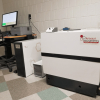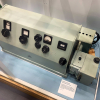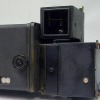Rita S. Brito,a Rita Ribeiro,a Tatiana Arriaga,b Catarina Leitão,b Nìdia D. Lourenço,b Filipa Ferreirac and Helena M. Pinheirob
aHydraulics and Environment Department, Laboratório Nacional de Engenharia Civil, Lisbon, Portugal
biBB, Department of Bioengineering, Instituto Superior Técnico, Universidade de Lisboa, Portugal.
E-mail: [email protected]
cCEHIDRO, Department of Civil Engineering, Architecture and Georesources, Instituto Superior Técnico, Universidade de Lisboa, Portugal
On-line monitoring of wastewater systems
Urban wastewater systems include drainage networks (sewers), to collect and transport wastewater, and treatment plants (WWTPs), to remove or detoxify the organic and inorganic components carried in it. Urban wastewater quality reflects its possible origins, e.g., sanitary, industrial, groundwater infiltration and storm water. To consistently meet regulatory performance standards, wastewater management requires advanced control and supervision frameworks. System dynamic modelling can support the decision process to increase the resilience of wastewater systems in a context of highly variable inputs. Data frequency is critical in any modelling exercise.1 For such dynamic processes, diurnal, weekly and seasonal patterns need to be characterised.
Wastewater quality characterisation usually involves monitoring campaigns at selected locations, with flow rate measurement and sampling with subsequent analyses in a laboratory. On-line monitoring is thus much needed to improve the knowledge base on operational dynamics and to provide early warnings on situations such as unauthorised discharges into the drainage network or equipment failures in WWTPs. With this information, managers would acquire the ability for timely response to input changes, reducing costs (e.g., energy for pumping and aeration) and performance deterioration risks (e.g., excessive pollution discharged into natural water bodies). However, due to the complexity and instrument costs, on-line monitoring in wastewater systems is still limited.
Spectrophotometry in the UV/visible (UV/vis) range provides very relevant information for wastewater quality evaluation, since a major part of its organic components, and some of the inorganic (e.g., nitrate), absorb radiation in this range.2 Also, radiation attenuation due to scattering effects can be used to infer the concentration and other quality attributes of the particulate pollutant fraction.3 The development of high quality optical fibres and submersible instruments with optical window cleaning systems allow this technique to be applied on-line in wastewater systems. Chemometric methods using advanced multivariate data analysis are applied to extract information from spectra. Besides quality fingerprinting through principal component analysis (PCA), spectral data can provide quantitative quality information through statistical regression models. Standard aggregate parameters, such as total organic carbon (TOC), chemical oxygen demand (COD) and total suspended solids (TSS) have been inferred using partial least squares (PLS) regression.4,5 Spectral pre-processing (e.g., smoothing, first and second derivatives, scatter correction) and wavelength range optimisation (e.g., interval PLS) provide enhanced quality and robustness to these predictions.6 It has thus been demonstrated that UV/vis spectroscopy is a powerful tool for waste‑water characterisation.7
On-line UV/vis spectrophotometry in two decentralised wastewater treatment plants
In rural areas, wastewater collection and treatment in small decentralised systems is an accepted practice. However, in many cases their territorial dispersion has led to largely unattended operation. Environmental risks rise from pronounced load variations in the inflows and inadequate design typically resulting in permanent organic underload.8 In this context, the use of on-line UV/vis spectrophotometry was tested in two decentralised WWTPs for inflow wastewater quality monitoring. Both WWTPs comprised extended aeration activated sludge bioreactors and gravity settlers, with intermittent aeration and biosludge wasting. The studies had in view a more rational management strategy, based on dynamic modelling of the treatment systems. In particular, a better basis was sought for decisions on aeration regimen and biosludge inventory control.
The first case-study was a WWTP treating the sewage from an 800-inhabitant village in the Castelo Branco district, Portugal. Flow meters and a submersible UV/vis spectrophotometer (Spectro::lyser, s::can Messtechnik GmbH, Austria) (see Figure 1) were installed at the plant inlet and data acquisition was carried out over five two-day campaigns during the period of one year. Sampling and laboratory analyses accompanied the on-line datasets and the generally good correspondence between reference (analytical) and spectra-based values can be seen in Figure 1.

Figure 1. The submersible spectrophotometer used for wastewater quality monitoring and the channel it was installed in, at the inlet of an 800-inhabitant, decentralised WWTP. Example of analytical (symbols) and spectra-based (lines) values for quality parameters measured on the wastewater at the inlet of the WWTP.
The acquired data allowed the functional characterisation of the treatment system, and the calibration and validation of a simplified, mechanistic model. Among other options, the model was used to test a simple scenario of automatic aeration control in response to defined inlet COD load ranges, resulting in a reduction of the daily aeration time from 7.7 hours to 4.2 hours, keeping treatment performance within regulatory limits.9 Moreover, control could be kept through a catastrophic failure of the inlet flow meter by simply using an average inlet COD load profile derived from the historical on-line data.
The second case-study was a WWTP sized for a 5000 inhabitant-equivalent load, mostly urban with livestock breeding wastewater inputs, in the Lisbon district, Portugal. A submersible UV/vis spectrophotometer (Spectro::lyser) was installed at the plant inlet, complementing the existing flow meter. On-line monitoring was sustained for one year, during which seven, two-and four-day sampling campaigns were carried out. Spectral data were examined using PCA, to identify abnormal situations, including excessive biosludge return to the WWTP inlet during malfunctions in the sludge processing line. Also, the optimum time for servicing of the spectrophotometer was identified in the PCA score plot and later confirmed by a drift in the predicted COD values (Figure 2, campaign V2).

Figure 2. Overview of analytical results and spectral estimates for COD on the wastewater at the inlet of a 5000 inhabitant-equivalent, decentralised WWTP (bottom graph). The divergence in values from the last campaign (V2) was anticipated in the score plot of the first two PCs in the PCA analysis of the on-line spectra (top graph) and pointed out the need for instrument servicing.
The acquired spectra were processed with PLS into software sensors for the estimation of the load of organic nitrogen at the inlet of the WWTP. Through interval PLS, an independent set of sample values could be predicted with a relative root mean squared error (RMSE) of 20%, for a range of 4.3–27.1 mgN L–1. Using these predictions, the treatment bioreactors could be modelled using a mechanistic formulation, with inlet flow rate, COD, organic nitrogen and ammonia nitrogen (measured on-line with an electrochemical sensor) as inputs. Dynamic simulations were thus possible to adjust aeration cycles in order to simultaneously optimise energy input, COD removal and advanced nitrogen removal.
On-line UV/vis spectrophotometry in an urban sewer network
The application of in situ UV/vis spectroscopy in sewers has not been reported often and is considered a step forward in drainage network management.4,10 However, in sewers the instruments are subjected to fouling and access for maintenance is limited. Additionally, when storm water inflows occur, marked changes the water quality matrix are observed.
In situ installations for submersible spectrophotometers may involve floating devices or a by-pass measuring flume outside the main sewer.10 In the present case, a floating support was specifically designed for temporary installation at four locations in a sewer network in the Lisbon district, Portugal.6 This support system (see Figure 3) consisted of a rigid structure surrounding the probe, protected by polyurethane foam cylinders for floating and shielding, anchored to the sewer access manhole at four points. The design ensured: 1) permanent submergence of the optical window to a depth of about one-third of the average water depth in the sewer; 2) probe alignment with the longitudinal axis of the flow; 3) free fluid circulation through the optical window, with no obstructions; 4) protection against collisions with large debris.
Rainwater inflow in sewers generally results in a dilution of dissolved matter and an increase in the suspended solids content, the nature of which varies along with rain events.2 UV/vis spectra, examined using PCA, were here used as a surrogate parameter to detect storm water inflow episodes.

Figure 3. The floating support system constructed for installation of the submersible UV/vis probe in the sewer. Score plot of the first two PCs in the PCA analysis of the on-line spectra acquired at one of the sewer locations, in wet and dry weather conditions.
Figure 3 presents a score plot of the PCA analysis of a spectral dataset acquired at one of the locations before and during a rain event. The possibility of detecting the change in wastewater matrix was confirmed. Thus, TSS and COD levels in the transported sewage could be estimated from the acquired spectra, using interval PLS regression, separately optimised for dry and wet weather situations. Independent datasets were predicted with RMSE values under 10% for both TSS and COD, for value ranges of 180–230 mg L–1 and 250–540 mgO2 L–1, respectively.6
Conclusions
The value of on-line UV/vis spectroscopy for wastewater quality monitoring in two different sewage management situations was confirmed. For decentralised wastewater treatment, spectral on-line monitoring of key quality parameters (COD, organic N) at the WWTP inlet was found to be possible, at two plants of different sizes and inflow characteristics. The produced data allowed the dynamic modelling of the treatment processes and the testing of control scenarios. In situ spectral monitoring in sewers was also successfully tested, with high potential in the management of drainage networks subjected to storm water inflows. In both situations, on-line UV/vis spectrophotometry can thus become a key technology for real-time system management, leading to better use of infrastructures and resources and the achievement of environmental objectives more consistently and at lower costs.
Acknowledgements
The contractor company Águas de Lisboa e Vale do Tejo, Portugal, is gratefully acknowledged for technical support. This work was financed by Fundação para a Ciência e a Tecnologia (FCT, Portugal) through grants PTDC/AAG-TEC/4124/2012, PTDC/AAC-AMB/102634/2008 and UID/BIO/04565/2013. R.S. Brito acknowledges FCT and Laboratório Nacional de Engenharia Civil for doctoral (SFRH/BD/46665/2008) and post-doctoral (0606/3212/2014) grants, respectively. N.D. Lourenço acknowledges FCT for a post-doctoral grant (SFRH/BPD/88095/2012).
References
- L. Rieger, S. Gillot, G. Langergraber, T. Ohtsuki, A. Shaw, I. Takács and S. Winkler, Guidelines for Using Activated Sludge Models. IWA Publishing, London (2013).
- O. Thomas, E. Baurès and M.F. Pouet, “UV spectrophotometry as a non-parametric measurement of water and wastewater quality variability”, Water Qual. Res. J. Can. 40(1), 51–58 (2005).
- N.D. Lourenço, F. Paixão, H.M. Pinheiro and A. Sousa, “Use of spectra in the visible and near-mid-ultraviolet range with principal component analysis and partial least squares processing for monitoring of suspended solids in municipal wastewater treatment plants”, Appl. Spectrosc. 64, 1061–1067 (2010). doi: http://dx.doi.org/10.1366/000370210792434332
- Torres and J.-L. Bertrand-Krajewski, “Partial least squares local calibration of a UV-visible spectrometer used for in situ measurements of COD and TSS concentrations in urban drainage systems”, Wat. Sci. Tech. 57, 581–588 (2008). doi: http://dx.doi.org/10.2166/wst.2008.131
- N.D. Lourenço, J.C. Menezes, H.M. Pinheiro and D. Diniz, “Development of PLS calibration models from UV-VIS spectra for TOC estimation at the outlet of a fuel park wastewater treatment plant”, Environ. Tech. 29, 891–898 (2008). doi: http://dx.doi.org/10.1080/09593330802015581
- R.S. Brito, H.M. Pinheiro, F. Ferreira, J.S. Matos and N.D. Lourenço, “In situ UV-Vis spectroscopy to estimate COD and TSS in wastewater drainage systems”, Urban Water J. 11, 261–273 (2012). doi: http://dx.doi.org/10.1080/1573062X.2013.783087
- J. van den Broeke, G. Langergraber and A. Weingartner, “On-line and in situ UV/vis spectroscopy for multi-parameter measurements: a brief review”, Spectroscopy Europe 18(4), 15–18 (2006). http://bit.ly/1SkMTU3
- A.K. Sharma, G. Tjandraatmadja, S. Cook and T. Gardner, “Decentralised systems—definition and drivers in the current context”, Wat. Sci. Tech. 67, 2091–2101 (2013). doi: http://dx.doi.org/10.2166/wst.2013.093
- R. Ribeiro, C.I.C. Pinheiro, T. Arriaga, H.M. Pinheiro and M.C. Almeida, “Model based fault diagnosis for performance control of a decentralized wastewater treatment plant”, Computer Aided Chemical Engineering, Vol. 33, Part A: Proceedings of the 24th European Symposium on Computer Aided Process Engineering – ESCAPE 24, Ed by J.J. Klemeš, P.S. Varbanov and P.Y. Liew., Elsevier, pp. 691–696 (2014). doi: http://dx.doi.org/10.1016/B978-0-444-63456-6.50116-2
- G. Gruber, J.-L. Bertrand-Krajewski, J. De Beneditis, M. Hochedlinger and W. Lettl, “Practical aspects, experiences and strategies by using UV/VIS sensors for long-term sewer monitoring”, Wat. Practice Tech. 1(1) (2006). doi: http://www.iwaponline.com/wpt/001/wpt0010020.htm
















